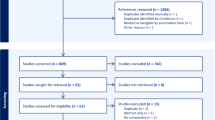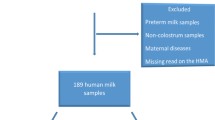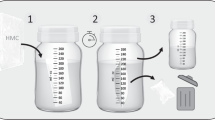Abstract
Objective:
Long-term storage of human milk (HM) requires freezing at low temperatures, the consequences of which upon macronutrients are unclear. To test the null hypothesis that HM freezing and storage for a range of 1 to 10 weeks at −80 °C does not affect HM fat, protein, lactose and energy contents.
Study design:
Samples of HM were obtained from 20 mothers (60 samples) of preterm infants (25 to 35 weeks gestation), who routinely expressed their milk, every 3 h, using an electric pump, from the second to the seventh week after delivery. All samples were frozen at −80 °C for 8 to 83 days (43.8 days average). After thawing and homogenization, energy and macronutrient contents were measured using an HM analyzer.
Result:
Fat, carbohydrates and energy contents were significantly lower in thawed HM than in fresh HM (fat, fresh vs thawed: 3.72±1.17 vs 3.36±1.19 g/100 ml, P<0.001; carbohydrates, fresh vs thawed: 5.86±0.71 vs 4.09±0.96 g/100 ml, P<0.001; energy, fresh vs thawed: 64.93±12.97 vs 56.63±16.82 kcal/100 ml, P<0.0001), whereas protein content remained unchanged (protein, fresh vs thawed: 1.14±0.36 vs 1.15±0.37 g/100 ml, P=0.7). The decline in carbohydrates content but not in fat and energy correlated significantly with freezing duration.
Conclusion:
Freezing at −80 °C significantly decreases the energy content of HM, both from fat and carbohydrates. Since quantitatively the decrease in macronutrients was much higher than that published for HM storage at −20 °C, our results do not support freezing HM at −80 °C as the gold standard for long-term storage. We suggest that caloric intake calculations in preterm infants cannot be established based upon fresh HM data.
This is a preview of subscription content, access via your institution
Access options
Subscribe to this journal
Receive 12 print issues and online access
$259.00 per year
only $21.58 per issue
Buy this article
- Purchase on Springer Link
- Instant access to full article PDF
Prices may be subject to local taxes which are calculated during checkout

Similar content being viewed by others
References
Section on Breastfeeding. Breastfeeding and the use of human milk. Pediatrics 2012; 129: e827–e841.
Agostoni C, Buonocore G, Carnielli VP, De Curtis M, Darmaun D, Decsi T et al. Enteral nutrient supply for preterm infants: commentary from the European Society of Paediatric Gastroenterology, Hepatology and Nutrition Committee on Nutrition. J Pediatr Gastroenterol Nutr 2010; 50: 85–91.
Hartmann BT, Pang WW, Keil AD, Hartmann PE, Simmer K, Australian Neonatal Clinical Care Unit . Best practice guidelines for the operation of a donor human milk bank in an Australian NICU. Early Hum Dev 2007; 83: 667–673.
Academy of Breastfeeding Medicine Protocol Committee. ABM clinical protocol 8: Human milk storage information for home use for full-term infants (original protocol March 2004; revision 1 March 2010). Breastfeed Med 2010; 5: 127–130.
García-Lara NR, Escuder-Vieco D, García-Algar O, De la Cruz J, Lora D, Pallás-Alonso C . Effect of freezing time on macronutrients and energy content of breastmilk. Breastfeed Med 2012; 7: 295–301.
Ogundele MO . Techniques for the storage of human breast milk: implications for anti-microbial functions and safety of stored milk. Eur J Pediatr 2000; 159: 793–797.
Silvestre D, Miranda M, Muriach M, Almansa I, Jareño E, Romero FJ . Frozen breast milk at −20 degrees C and −80 degrees C: a longitudinal study of glutathione peroxidase activity and malondialdehyde concentration. J Hum Lact 2010; 26: 35–41.
Tacken KJ, Vogelsang A, van Lingen RA, Slootstra J, Dikkeschei BD, van Zoeren-Grobben D . Loss of triglycerides and carotenoids in human milk after processing. Arch Dis Child Fetal Neonatal Ed 2009; 94: F447–F450.
Silprasert A, Dejsarai W, Keawvichit R, Amatayakul K . Effect of storage on the creamatocrit and total energy content of human milk. Hum Nutr Clin Nutr 1987; 41: 31–36.
Friend BA, Shahani KM, Long CA, Vaughn LA . The effect of processing and storage on key enzymes, B vitamins, and lipids of mature human milk. I. Evaluation of fresh samples and effects of freezing and frozen storage. Pediatr Res 1983; 17: 61–64.
Author information
Authors and Affiliations
Corresponding author
Ethics declarations
Competing interests
The authors declare no conflict of interest.
Additional information
This study was presented in part at the PAS annual meeting in Washington DC, USA, 2013.
Rights and permissions
About this article
Cite this article
Lev, H., Ovental, A., Mandel, D. et al. Major losses of fat, carbohydrates and energy content of preterm human milk frozen at −80°C. J Perinatol 34, 396–398 (2014). https://doi.org/10.1038/jp.2014.8
Received:
Revised:
Accepted:
Published:
Issue Date:
DOI: https://doi.org/10.1038/jp.2014.8
Keywords
This article is cited by
-
Changes in macronutrients of human milk after bolus feeding: a simulation study
Journal of Perinatology (2021)
-
A randomized controlled trial protocol comparing the feeds of fresh versus frozen mother’s own milk for preterm infants in the NICU
Trials (2020)
-
Testing the feasibility and safety of feeding preterm infants fresh mother’s own milk in the NICU: A pilot study
Scientific Reports (2019)
-
The effect of maternal habitus on macronutrient content of human milk colostrum
Journal of Perinatology (2017)
-
The effect of between-breast differences on human milk macronutrients content
Journal of Perinatology (2016)



